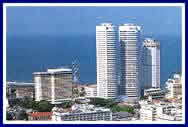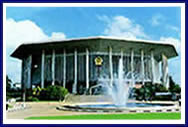|
Sri Lanka's capital upto recent times, Colombo, is a
fascinating city, not only for a comfortable blend of east and west, but
also for a cosy mixture of the past and present. It is still the
commercial centre of the country. Situated 34 km. from the International
Airport, Colombo has been a flourishing seaport for centuries. Today the
bustle of the harbour mingles with the activity of its busy commercial,
banking and shopping areas. The original trading settlers - the
Portuguese, Dutch and the British have all left in their wake churches and
monuments, names and religions, costumes and food and smatterings of their
languages which have been absorbed into the speech of the Sri Lankans.
Colombo, with its population of over half a million is divided into
fifteen zones. Colombo has 600,000 population and it has warm and
sunny typical weather.
While in Colombo attractions
worth seeing are:- Buddhists temples, Hindu temples, Mosques, Christian
churches, Parliament building, Parks, Zoo, Museums and Art Galleries. A
half day tour covering 40 km. and including visits to a Buddhist Temple,
Hindu Temple, the Zoo and the residential areas will cost around US $ 18
for a car with a chauffeur guide.
Cosmopolitan
Colombo is the modern commercial city and the spirited
maritime capital of Sri Lanka. The co-existence of the old and the
new, such as, from the oldest department stores of Cargills to the
prestigious World Trade Center, the remnants of the colonial
legacies to the enthralling shopping complexes, traditional sarongs
to the flashy western fashions or a bullock cart to a speedy sports
car, make Colombo one of the diverse exhibits in the country. It has
a history as early as the eighth century A.D when the Arab traders
used it as a port for the shipping of cinnamon.
 Most of the hotels are
gathered around the seaside Galle Face Green, where horse
racing and colonial army parades were held. But now it is used for
public events, and on weekends cricket or football games are common
occurrences. More popularly, it is a place to go to fly a kite.
During the seasons, competitions are held and colourful kites are
sold. Cheap food and the best shopping can be found in the Fort and
Pettah districts. Most of the hotels are
gathered around the seaside Galle Face Green, where horse
racing and colonial army parades were held. But now it is used for
public events, and on weekends cricket or football games are common
occurrences. More popularly, it is a place to go to fly a kite.
During the seasons, competitions are held and colourful kites are
sold. Cheap food and the best shopping can be found in the Fort and
Pettah districts.
 Beira lake margins Slave
Island, [few kilometres away from the Galle Face Green] which was
once the hometown of the slaves, decided by the caste system. The
lake holds two minute islands of particular interest. One is the
Amusement park and the other is the Simalaka, a Buddhist hall built
onto the lake Beira lake margins Slave
Island, [few kilometres away from the Galle Face Green] which was
once the hometown of the slaves, decided by the caste system. The
lake holds two minute islands of particular interest. One is the
Amusement park and the other is the Simalaka, a Buddhist hall built
onto the lake
Stretching
along with the roads of Colombo seven is Viharamahadevi park ;
named after a legend of a Sinhalese queen. It demarcates the largest
cinnamon plantation in the region once. There are a variety of rare
and valuable trees growinglavishly on the lushes of green turf.
Lotus ponds, orchid houses, fountains, children's park, open air
theaters and a zoo for baby animals make the park one of the most
organized places in town.
 In
the outer skirts of Colombo Seven lies The Independence Memorial
Hall. It is constructed of pillars of medieval Kandiyan
style.Bas-relief bronze panels depict scenes from the country's
history and there is a separate gallery of paintings and sculptures
in the basement.Riding down the roads would take one to The Bandaranayaka
Memorial International Conference Hall, best know by its
acronym,BMICH. It is a gigantic octagonal building and one of the
finest convention halls in South Asia. In
the outer skirts of Colombo Seven lies The Independence Memorial
Hall. It is constructed of pillars of medieval Kandiyan
style.Bas-relief bronze panels depict scenes from the country's
history and there is a separate gallery of paintings and sculptures
in the basement.Riding down the roads would take one to The Bandaranayaka
Memorial International Conference Hall, best know by its
acronym,BMICH. It is a gigantic octagonal building and one of the
finest convention halls in South Asia.
Heading towards the
harbour, one is sure to encounter armed uniformed sentries guarding
the tall iron gates of the president's house where many
distinguished guests are hosted. The statue of the British governor
Edward Barns stands amidst the foliage when peering through the
gates for a glimpse.
The roads that
stretch to the east of Colombo would take one to the administrative
capital of Sri Lanka Sri Jayawardanapura Kotte. The
parliamentary complex is a simple oriental structure with
architectural beauty, which is surrounded by the waters of the
Diyawanna Oya. |